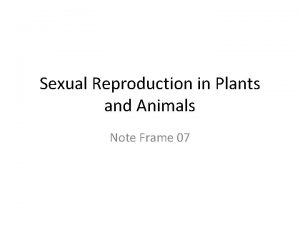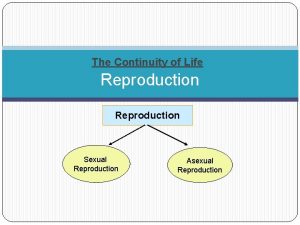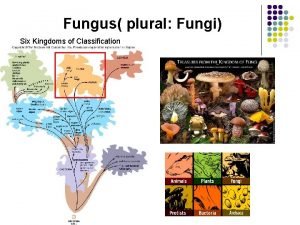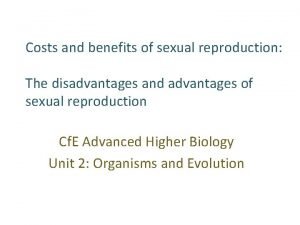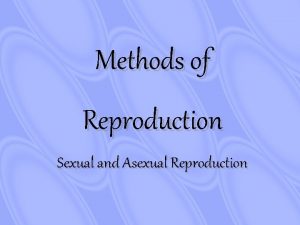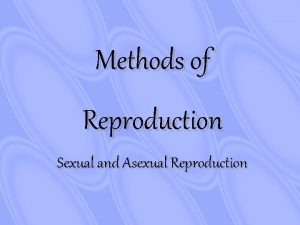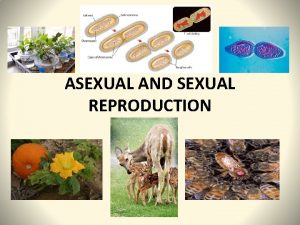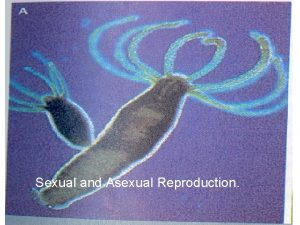Methods of Reproduction Sexual and Asexual Reproduction See














- Slides: 14

Methods of Reproduction Sexual and Asexual Reproduction See reference section

Asexual Reproduction: By definition: it is a process that requires only one parent and the offspring are an exact copy of the parent---a clone

Asexual Reproduction: • Organisms that reproduce asexually cannot develop much variety, because they are “copying” the original organism exactly.

Methods of asexual reproduction: Binary fission Budding Fragmentation Parthenogenesis

Binary fission Single-celled organisms (Amoeba, paramecium, euglena) which use asexual reproduction can do so simply by dividing into two equal halves. This is called binary fission.

• When conditions are good, such as plenty of water, food, right temperatures, etc. , binary fission is a very effective way of producing many, many offspring. • For example, the cell of a Paramecium can divide, grow, and divide again in the space of 8 hours.

Budding- an offspring grows out of the body of the parent. offspring Hydra Budding Cactus Budding

Budding In yeasts the cell does not divide equally in two halves; instead, there is a large mother cell and a smaller daughter cell. Yeast - budding

Fragmentation In this form, the body of the parent breaks into distinct pieces, each of which can produce an offspring. Pieces of coral broken off in storms can grow into new colonies. A new starfish can grow from one detached arm.

Fragmentation- plant cuttings Some plants can grow from cutting them up and replanting them.

Green plants are quite sophisticated in their methods of asexual reproduction. Offspring may be produced by runners, bulbs, rhizomes or tubers.

Parthenogenesis is a form of asexual reproduction in which females produce eggs that develop without fertilization. Parthenogenesis is seen to occur naturally in some invertebrates, along with several fish, amphibians, and reptiles as well as in many plants. There are no known cases of parthenogenesis in mammals.

Review questions • Where does mitosis occur? What type of cells are found in multicellular organisms? • What is a gamete? Is it the same as a somatic cell? • What do the terms diploid and haploid mean? Abbreviations: (2 n, and n) • Reminder: mitosis occurs in the nucleus, binary fission and budding are the processes by which the organism reproduces.

References for power point https: //www. youtube. com/watch? v=d 5 d. OSya. KWTQ
 Sexual reproduction and asexual reproduction
Sexual reproduction and asexual reproduction Venn diagram of sexual and asexual reproduction
Venn diagram of sexual and asexual reproduction Venn diagram asexual vs sexual reproduction
Venn diagram asexual vs sexual reproduction Two types of reproduction
Two types of reproduction Animal chromosome number
Animal chromosome number Sexual and asexual reproduction in animals venn diagram
Sexual and asexual reproduction in animals venn diagram Asexual reproduction cell division
Asexual reproduction cell division Examples for sexual reproduction
Examples for sexual reproduction Where does cactus store water
Where does cactus store water Parthenogenesis in mammals
Parthenogenesis in mammals An example of asexual reproduction
An example of asexual reproduction Asexual or sexual reproduction
Asexual or sexual reproduction Sexual or asexual reproduction
Sexual or asexual reproduction Kickxellomycotina
Kickxellomycotina Parthenogenesis asexual reproduction
Parthenogenesis asexual reproduction








